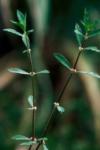Latin name
Alternanthera sessilis (L.) R. Br. ex DC.
Family
Amaranthaceae
Common name(s)
Sessile joyweed
Synonym(s)
Alternanthera denticulata R. Br., A. ficoidea (L.) P. Beauv., A. polygonoides (L.) R. Br., A. triandra Lam., Gomphrena polygonoides L., G. sessilis L.
Geographical distribution
Asia: China (including Taiwan) and Japan.
South and Southeast Asia: Bangladesh, Cambodia, India, Indonesia, Lao PDR, Malaysia Myanmar, Nepal, Philippines, Sri Lanka, Thailand, and Vietnam.
Rest of the world: Benin, Botswana, Cameroon, Colombia, Congo-Kinshasa, Cote d'Ivoire, Dominican Republic, Ecuador, Egypt, Fiji, Ghana, Guinea, Iran, Iraq, Jamaica, Jordan, Kenya, Mauritius, Micronesia, Mozambique, New Guinea, Nigeria, Puerto Rico, Senegal, South Africa, Sudan, Surinam, Tanzania, Trinidad, Uganda, United States (Hawaii), West Polynesia, Zimbabwe, and Zambia.
Morphology
Prostrate, creeping, or ascending annual or short-lived perennial herb.
Stem: branched up to 100—cm—long, often rooting at nodes, lower part had 2 lines of hairs on internodes.
Leaf: opposite, hairless or nearly so, sessile or shortly stalked, narrowly lanced-shaped to obovate, 1—12—cm—long and 2.5—3—cm—wide.
Inflorescence: solitary or clustered heads borne in axils of leaves, white-flowered, globose to oblong, up to 7—mm—long.
Fruit: dark brown, inverted kidney-shaped single-celled bladder, seed shiny black.
Biology and ecology
Prefers moist conditions and grows on a wide range of soil types. Commonly found on sides of drains and canals around lowland rice fields. Propagated by seed and stem fragments, and may flower throughout the year. Up to 2,000 seeds can be produced by a single plant.
Agricultural importance
A weed of maize, root crops, plantation crops, and rice. An alternative host of root-knot nematodes, Meloidogyne incognita and Pratylenchus coffeae.
Management
Cultural control: hand weeding and tillage.
Chemical control: reported to be controlled by amitrole, bensulfuron, 2,4-D, MCPA, oxadiazon, and propanil. In India, economic control was achieved by applying 2,4-D at 20 days after rice plan
Selected references
Ampong-Nyarko K, de Datta SK. 1991. Handbook for weed control in rice. Los Baños (Philippines): International Rice Research Institute. 113 p.Datta SC, Biswas KK. 1979. Autecological studies on weeds of West Bengal. VIII. Alternanthera sessilis (L.) DC. Bull. Bot. Soc. Bengal 33(1):5-26.Goodey JS, Franklin MT, Hooper DJ. 1965. T. Goodey's the nematode parasites of plants catalogued under their hosts. Walingford (UK): CAB International.Holm L, Pancho JV, Herberger JP, Plucknett DL. 1979. A geographical atlas of world weeds. New York (USA): John Wiley & Sons, Inc. 391 p.Moody K. 1989. Weeds reported in rice in South and Southeast Asia. Manila (Philippines): International Rice Reseach Institute. 442 p.Moody K. 1992. Weeds of cropped areas in the Philippines. Philipp. J. Weed Sci. 19:31-78.Moody K, Munroe CE, Lubigan RT, Paller Jr. EC. 1984. Major weeds of the Philippines. Weed Science Society of the Philippines. Los Baños (Philippines): University of the Philippines. 328 p.Soerjani M, Kostermans AJGH, Tjitrosoepomo G. 1987. Weeds of rice in Indonesia. Jakarta (Indonesia): Balai Pustaka. 716 p.
Contributors
JLA Catindig, RT Lubigan, and DE Johnson
